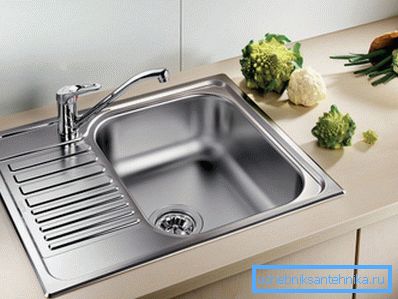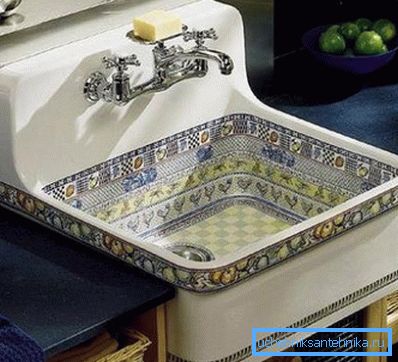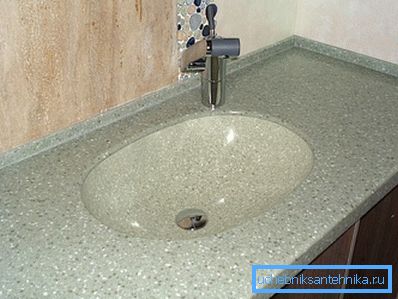Sink-sink: differences in models
If you want to find out how the sink differs from the sink, then I can disappoint you, since the differences, as such, in fact, do not exist. Simply, the bowl, which is called the sink, is often used in the kitchen to wash dishes (hence the name), and the same vessel in the bathroom is already called a sink.
So, let's find out about the structural varieties of such plumbing fixtures and materials from which they are made, as well as watch the video in this article.

Sinks and sinks
Note. Sinks mainly differ in shape, material and method of installation. Almost all of the existing products can be used in the kitchen - it all depends on the interior and the capabilities of the homeowner.
Material Differences

- The most common material for such a plumbing unit as a sink and sink for the kitchen is stainless steel. (in the Soviet period, such products were made of black sheet steel and painted). The metal bowl is convenient because it is very easy to install because of its low weight, and besides, it is not afraid of sudden changes in temperature, which often happens when washing dishes, aggressive chemicals and abrasion.
- As a rule, such shells are mounted in a laid-on way, although occasionally you have to resort to a tie-in, if the tabletop on the cabinet is solid, without a seat. The bowl itself may have a different shape, therefore, it can be used for a kitchen facade of any type. Near the tank, on the right or on the left side there can be a pedestal in the form of a metal corrugated table.

- For a more luxurious interior, marble or granite sinks and countertops can be used., but their price is too high, and the large mass of the product greatly hinders its installation. Therefore, since 1986, they began to use a composite material that is no different in appearance, and sometimes even surpasses the texture of natural stone. Of course, each manufacturer introduces something of its own in the manufacture of the composite, but the essence of the composition and principle of production has remained unchanged until now.
- As a mineral filler in such products is granite or marble chips of medium or small fraction, which takes up to 80% of the total volume, which are mixed with polyester resins and any coloring pigment such as titanium dioxide. The resulting mixture is poured into the shape of the desired configuration and compacted on the vibrating table, and after full solidification they are ground on a polishing machine. Such sinks in terms of technical characteristics are almost as good as stainless steel counterparts, but at the same time they are very beautiful, have a deep texture and a presentable look.

- Artificial onyx on the manufacturing principle is also the same composite material., although its composition is as different as, about 65-67% alumina and from 2% to 7% of color paste are used as filler instead of minerals. All this is mixed with a polymer resin and the catalyst is added as a hardener. After that, everything happens as with artificial granite and marble - pouring into the mold, shrinking on the vibrating table and grinding.
- But aluminum oxide does not have such hardness as mineral crumb, therefore, the finished product is pasted over with a special film., protecting it from the effects of rubble chemistry and scratching with sharp objects. However, in total, such a composite is no worse, and on the side of the number of shades and patterns there are even more possibilities, and it is successfully used for kitchens with a variety of interiors.

- Shells are also made from ceramics, which differ in composition, that is, it can be either faience or porcelain.. It is almost impossible to visually distinguish these materials when the product is ready for use, since more porous earthenware is coated with icing. In the kitchen, such bowls are used extremely rarely, as they are afraid of temperature fluctuations and shocks - at such loads ceramics crack and its use, as a rule, is possible only with a dishwasher.
Differences by type of installation

The easiest way to carry out the installation of the installation, when the sink with a sink for a bathroom or kitchen is superimposed on the cabinet or on the cut-out in the tabletop. The product itself is a round, oval, square, rectangular or even triangular bowl of the sink with horizontal ribs on which it rests.
The convenience of this design lies in the fact that there is no need for additional fasteners and the capacity is kept in the seat due to its own weight.
But this type of installation is not always as simple as it was mentioned above - the fact is that the counter bowl of the sink can also be installed on a cabinet with a solid tabletop, and for this you have to do a sidebar.
In cases where the tabletop is made of chipboard with plastic coating, it is quite simple to do this - the hole is cut with an electric jigsaw or a mill, but sometimes you have to cut composite materials, which is not so easy and for this usually resort to the help of specialists.

You can buy a sink for the kitchen with a uniform worktop - in such cases, the mounting hole is ready and all you need to do is to set the bowl on the glue, after which there will not even be a visible seam. But here, too, sometimes you have to cut this seat yourself or hire a specialist.

In addition, recessed sinks can be installed either below the tabletop level or flush with the tabletop - in any of these cases, self-cutting of the bore hole will be extremely difficult, as smooth and polished edges will be needed there - this is required by aesthetics and installation instructions.
Note. All the shells mentioned above, regardless of the material and method of installation, can be single, double or even triple. In addition, their shape can be a square, rectangle, triangle, circle, oval, semi-oval, or arc.
Conclusion
In conclusion of the above, we can say that installing any car wash with our own hands does not look very difficult, unless, of course, you do not need to cut the tabletop. But even the sidebar will not interfere with self-assembly, but this is already in another material.